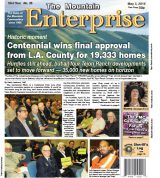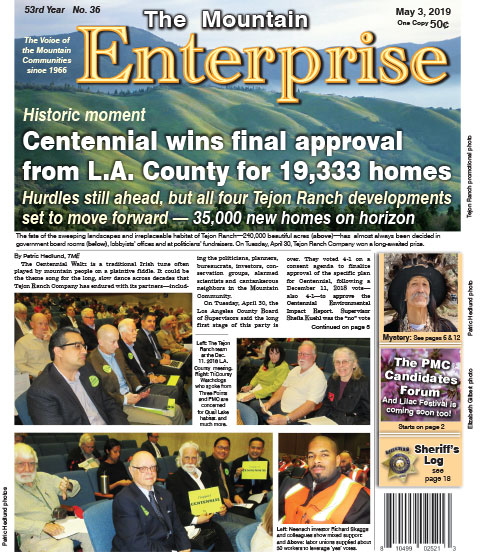By Patric Hedlund, editor
Editor@MountainEnterprise.com
The lush meadows and forests first caught the eye of an Irish potato-famine refugee, who arrived in California as a U.S. Army Dragoon. After his stint at Fort Tejon in 1855, John Cuddy homesteaded the valley that bears his name today.
Mr. Cuddy’s homestead is a pristine and magical delight to those who rise early each day, still half-dreaming, to swim eastward through the valley’s misty dawn to get to work. They float back home again on the tide of time that washes west toward the sunset over Cuddy Valley Road.
In winter, the forest that encircles this perfect little secret is flocked in snow. It comes alive with flowers and vibrant grasses in the springtime. Calves run through the meadow below the piñons in the fall. It is a gift to share the beginnings and endings of days with this quiet prayer of a place.
If the plans go forward that the U.S. Forest Service reports on pages 7 [Forest Officials Greenlight Tecuya Logging] and 9 [OpEd: Forest thinning plans will protect the Mountain Communities, (which is followed by OpEd Reply: Expedited logging won’t protect Mountain Communities)], it is likely that the appearance of Cuddy Valley may change dramatically in the near future.
Is it really possible that logging companies will find enough market-worthy timber between the scraggly piñons on these slopes to merit bringing logging crews and trucks to these hills to drag the big trees out and leave shattered, “masticated” rubble behind?
Will logging crews be turned loose to pull out the large trees on Tecuya Ridge that provide 47 documented roosts for the endangered California condor? The ancient bird with the 12-foot wingspan and a learning-culture evolved with this land. The elder birds show younger birds how to use the high ridges and tall trees on those ridges to leap onto the thermals that slingshot them toward the highlands of Tejon Ranch, overlooking the San Joaquin Valley where hot air smacks against the mountains, then pushes upward, creating a second tier of thermals that, in turn, slingshot the condors aloft again, to glide over the Sierras, watching for activity on the ground below that might signal the presence of food.
I would plead guilty to being overemotional and under-informed if I hadn’t experienced what the “treatment” to the forest and meadow west of Pine Mountain Club left behind 11 years ago.
Piles of broken trees and shattered limbs were torn off by giant metal jaws and spit into debris fields, creating chaos of the habitat like the aftermath in a battlefield, or a hurricane.
Now piles of dead wood writhe in a pyramid of bones on the walking trails, funeral pyres waiting to be lit by a slicing knife of lightning.
You may wish to mark your calendar for the Saturday, May 11 Open House at the Mount Pinos Ranger District Chuchupate Station, from 10 a.m. to 2 p.m. Go to meet the ranger. Ask your questions about this logging projects on Tecuya Ridge and Cuddy Valley.
Is it being pushed from Washington, D.C.? Does it really offer protection from fire to the people of these mountains? Or does it expose us to greater threats?
After the terror of the Camp fire—the roaring, wind-driven storm of flying embers that accelerated across “treated fuel breaks” to incinerate Paradise—such a public debate here would be timely, but was not held.
The use of a handy bureaucratic tool called “categorical exclusion” insulates forest managers from having that conversation. It efficiently removes people, their questions, their facts, discovery, study and scientific transparency from the equation.
Let us hope this procedural abuse of the National Environmental Protection Act (NEPA) is a quirk, a temporary political way station, not a permanent template for the future of how the U.S. Department of the Interior and the USDA is re-engineering interaction with the public who live here.
And Centennial…with Tejon Mountain Village…and Grapevine
[ Centennial wins final approval from L.A. County for 19,333 homes on page 1 this week]
Hurdles still ahead, but all four Tejon Ranch developments set to move forward — 35,000 new homes on horizon
There is nothing quite like 35,000 new housing units being built next door to change the neighborhood. That is the number of homes the Tejon Ranch Company has won entitlements for now. So, let’s see, at an average American family size of 2.6 people these days, 35,000 new homes would equal about 91,000 new people to share the Grapevine with you every day…or maybe 91,000 people to share our favorite forest pathways. Do you think the trees and critters will mind?
For all who want a big supermarket nearby, will 91,000 new neighbors be enough to attract the services you’ve been wishing for? Perhaps not a Trader Joe’s, nor a Gelson’s. Perhaps not a hospital, but maybe a good Thai restaurant or two.
In a decade the number of housing permits will trigger the requirement to build a sheriff’s substation and a fire station closer to Neenach. They’ll need it.
To see full stories with photos, please purchase a copy of the newspaper at many locations (click this link for a list) throughout the Mountain Communities.
Or, have your newspaper delivered via mail and include internet access. Just call 661-245-3794. Classified ads are FREE to paid subscribers! See front page at www.mountainenterprise.com for details.
The e-Edition is available now with full photos and stories at The Mountain Enterprise e-Edition. Select the 2019-0503 edition.
(subscriber login required)
This is part of the May 3, 2019 online edition of The Mountain Enterprise.
Have an opinion on this matter? We'd like to hear from you.

![[photo by Patric Hedlund, The Mountain Enterprise]](https://mountainenterprise.com/wp-content/uploads/TejonCentennialExecs_web2-324x218.jpg)

